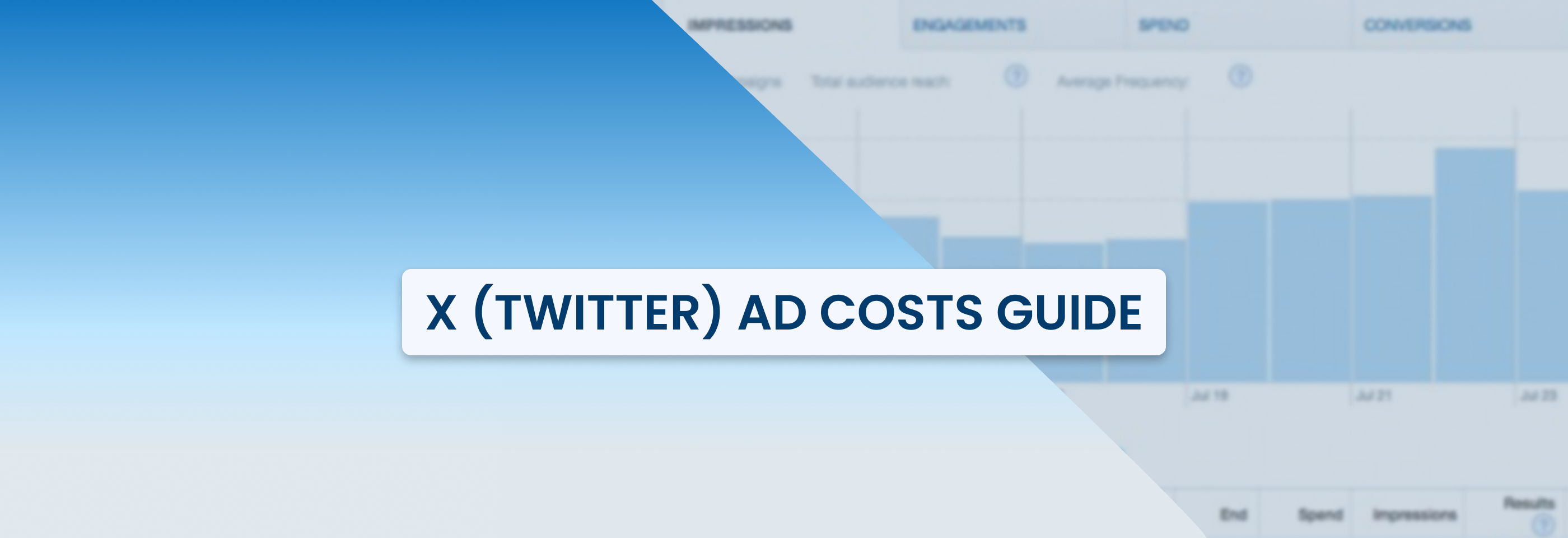B2B Marketing Made Simple: Best Strategies for Your Business
2024-09-06
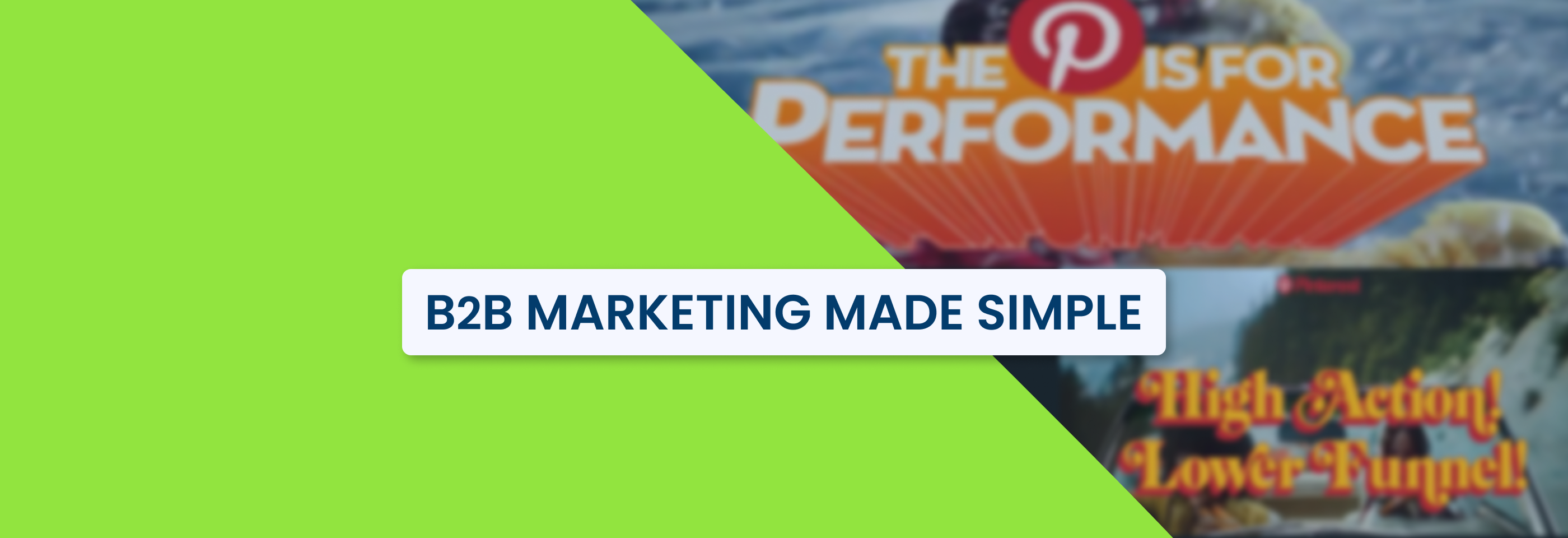
B2B marketing might seem complex or uninteresting, but it doesn’t have to be.
In this article, we’ll simplify the basics of B2B marketing, show you how it differs from its B2C counterpart, and share actionable tips for creating effective campaigns.
So, join us as we dive in and explore how to make B2B marketing both impactful and engaging.
What is B2B Marketing?
B2B marketing stands for "business-to-business" marketing, i.e. when one business is selling to another business. So, instead of aiming at individual customers, you’re targeting other businesses.
For example, think of a company that makes software to help businesses keep track of their sales teams. That software isn’t meant for the average person – it’s for businesses that need help managing sales, so that’s who you need to be targeting with your campaigns. This usually includes the decision-makers – managers or executives who decide if their company should buy your product.
Since many businesses do a lot of research online before talking to salespeople, the primary goal of B2B marketing is to show these companies how your product or service can solve their problems. You can do this by creating content like blog posts, case studies, or white papers that answer their questions and explain why your product is the best option.
In the end, it's all about understanding what other businesses need and showing them how your product or service makes their lives easier.
B2B vs. B2C marketing: what's the difference?
If B2B marketing is aimed at other businesses, B2C is aimed at regular consumers, i.e. the individual people – that’s the key difference from which all the others stem.
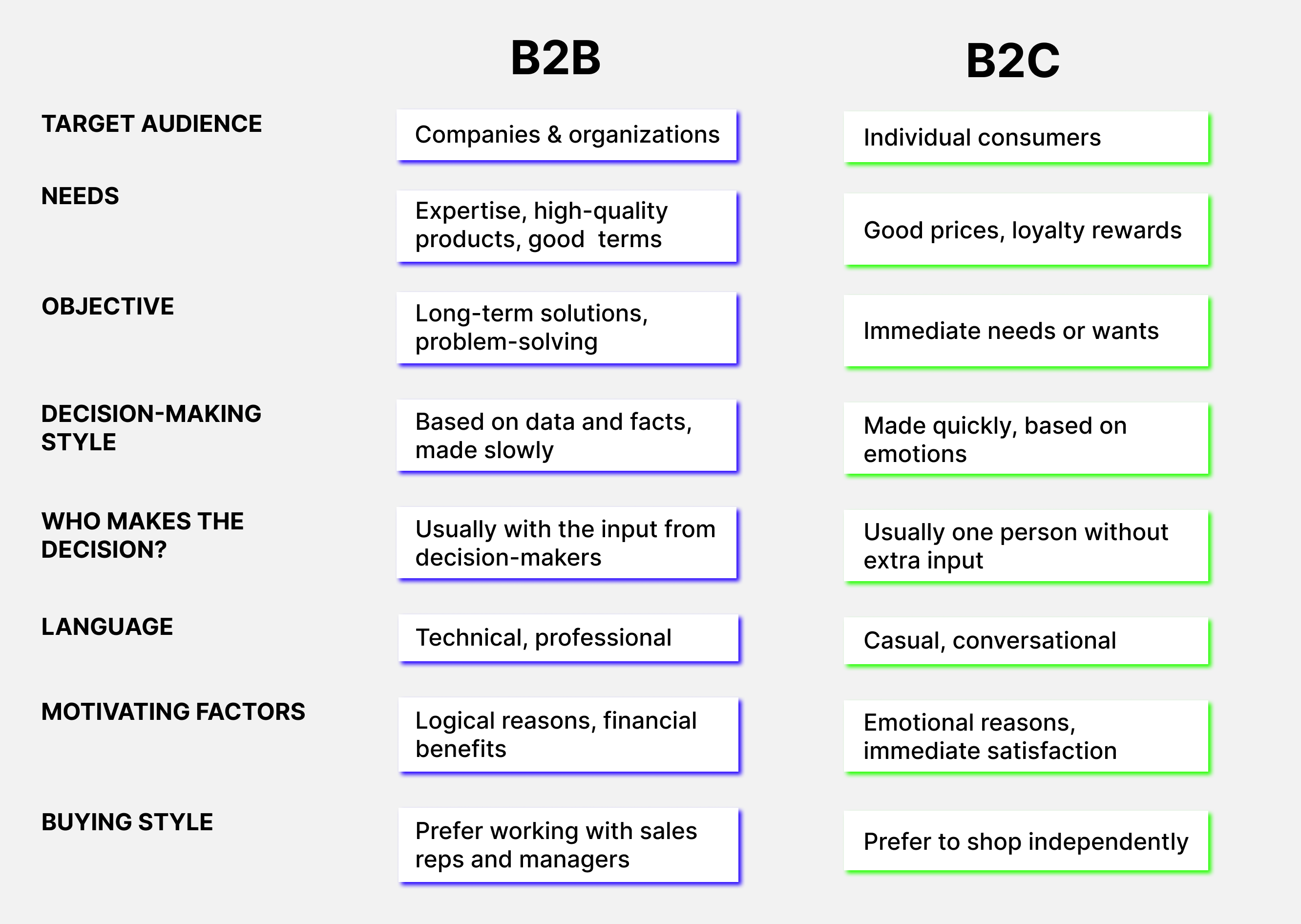
Here’s the breakdown of these differences:
- Decision-making process: in B2B marketing, buying decisions take longer because multiple people, like managers or teams, are involved. In B2C marketing, decisions are made faster by individuals based on their personal needs and feelings.
- Focus on value: B2B marketing shows how your product can solve specific business problems and help a company. B2C marketing is more about how a product can quickly make someone's life better or more enjoyable.
- Content and communication: B2B marketing often uses detailed and technical content to help businesses make smart decisions. B2C marketing content is usually designed with emotional appeal in mind.
- Building relationships: in B2B, you’re building long-term relationships through nurturing leads and supporting them through a longer buying process. B2C marketing focuses more on making quick sales and doesn’t always emphasize building long-term connections.
Now, let’s dive a bit deeper into B2B marketing and consider one possible framework you can use for your campaigns.
B2B marketing strategy framework
Creating a solid B2B marketing strategy is a bit more complex than B2C because you’re dealing with longer sales cycles and more decision-makers. But in its essence, it’s still all about guiding potential customers through a journey from discovery to purchase, and beyond.
The B2B buyer’s journey typically has the same four main stages as the B2C journey:
- Awareness: a business realizes it has a problem and starts looking for solutions. Your goal is to grab their attention and show them that your product or service could help. You can do this with blog posts, social media, or videos that explain how you can solve their problem.
- Consideration: the business is comparing different options and figuring out what’s best for them. This is where you provide detailed information like case studies, webinars, and white papers to show why your solution is better than the rest.
- Decision: the business is almost ready to make a purchase but needs a little extra convincing. This is where your sales team steps in with product demos, proposals, and any other details needed to close the deal.
- Retention: after the sale, keep in touch with the customer. Offer ongoing support and make sure they’re happy with their purchase. A satisfied customer is likely to stay loyal and might even recommend you to others.
To get more businesses and decision-makers to go through your funnel, you need to bring in new leads. There are two main approaches to do this:
Lead generation
This approach is about attracting as many potential leads as possible: you use ads, content, and sign-ups to cast a wide net. For example, you might post articles or infographics on LinkedIn so anyone who’s interested can find you, run Google ads with keywords like “best CRM software”, or offer free materials in exchange for contact information through email marketing.
The goal here is volume: you want a lot of leads coming in, and then you nurture them over time. It’s great for businesses trying to expand their audience or get a lot of people into the funnel at once.
But there’s a downside — while you might get a lot of leads, not all of them are going to be high-quality. Some might not be a great fit for your product, and you could end up wasting time chasing leads that don’t convert.
Account-based marketing (ABM)
ABM is a more focused strategy: instead of going broad, you target a few high-value companies that you really want to do business with.
With this approach, you can run LinkedIn ads only for the decision-makers at specific businesses you're trying to work with. Or, you could send personalized emails to key people at those companies, talking directly about their business challenges and offering your solutions.
You can also create customized landing pages for different types of businesses, showing them how your product can be integrated into their context.
It definitely takes more work and time, but often leads to better results – you’re targeting companies that are already a good match for your product.
So, how do you know which one to use? It depends on your goals.
If you’re trying to build brand awareness and bring in a lot of new leads, use lead generation. If you’re looking to win over specific, high-value clients, account-based marketing is probably your best bet.
But you don’t have to pick just one – many businesses use a mix of both. You can use lead generation to fill up your funnel with a broad audience while also running ABM campaigns for your top priority accounts. Ultimately, the key is knowing where your customers are in the journey, meeting them there, and helping them move forward.
If you've noticed, we already mentioned a couple of B2B marketing channels. Since your choice of these channels will also influence the success of your campaigns, let’s talk about them in more detail.
Best B2B marketing channels
Picking the right channels for B2B marketing = reaching the right people at the right time.
It’s the simple truth — you don’t want to waste time or money putting out content or ads where your audience isn’t. If your target customers aren’t on Facebook, why spend your budget there?
In B2B, you’re dealing with decision-makers like CEOs, managers, or specialists. Statistically, they’re more likely to hang out on professional networking platforms, read industry blogs, or join webinars because they’re searching for solutions. But it's not all there is to B2B marketing channels.
Here are the options you can explore:
1. LinkedIn
LinkedIn is pretty much the go-to platform for B2B marketing because it’s all about networking and building relationships with other businesses. It’s packed with professionals, business decision-makers, and industry leaders.
LinkedIn ads are great for reaching people by job title, industry, and company size. LinkedIn is also great for sharing industry insights, blog posts, or promoting webinars - you can establish your industry authority there.
2. Google
Google ads are ideal for search engine marketing and reaching people who are actively looking for business solutions – It’s a direct way to connect with potential buyers.
This includes both Google ads and SEO: one is used for short-term and fast results, while the other’s purpose is to get stable and consistent results that add up over the time.
3. Facebook
Facebook, as one of the top social media platforms in the world, is more consumer-focused – usually, it’s used for B2C or D2C marketing. But it can still work for B2B: Facebook ads let you target users based on interests, behaviors, interactions with your business, and a lot more. You’ll have a lot of targeting options for reaching people at different stages of your sales funnel.
Plus, with Facebook’s user base, you can reach a much wider audience than on LinkedIn, though it might not be as specific to business professionals.
4. X (Twitter)
X (Twitter) is great for quick updates, real-time engagement, and sharing content like blog posts or whitepapers. It’s pretty fast-paced and hard to navigate, but can be very useful for staying visible in your industry. X ads can also be useful if you approach them the right way.
5. YouTube
Product demos, explainer videos, customer testimonials, and webinars can be very engaging and useful for B2B decision-makers, especially for complex products. That’s why YouTube is a good option for B2B businesses that want to create video content, whether we're talking about the organic strategy or YouTube ads. Besides, YouTube videos show up in Google search results, which can give you extra visibility.
6. Email marketing
Email is one of the most direct channels for B2B marketing. You can send personalized messages, nurture leads, and promote content to stay in front of your audience and push them further down the sales funnel. Plus, it’s often one of the most cost-effective channels – something you should remember if you want to keep your campaigns budget-friendly.
7. Content platforms (Medium, Substack, etc.)
If you’re looking to publish longer-form content like articles, guides, or thought leadership pieces, platforms like Medium or Substack can help. This can help you position your business as an authority in your industry, connect with people who want to dig deeper into specific topics, and see what needs your potential customers can have.
8. Traditional advertising & marketing methods
Finally, don’t forget about traditional methods of promotion: print ads, trade shows, direct mail, and outdoor advertising. While less flashy and often more expensive, these methods can still make a big impact when paired with your digital campaigns.
Print ads and outdoor advertising offer a tangible way to reinforce your brand and reach potential clients in their everyday environment. Trade shows and industry events can help you reach people in professional settings where they can be more receptive to your offers.
By picking the right mix of marketing channels, you can reach more people and do it where and when it will give the best results. Next, let’s focus on what makes B2B campaigns truly successful besides the right channels.
How to create successful B2B marketing campaigns
What comes to mind first when you think about B2B advertising or marketing campaigns?
They often get a bad rap for being boring, too technical, or lacking creativity. When we talk about being original and creative, it’s usually B2C campaigns that take all the credit.
The good news is that it doesn’t have to be that way – B2B campaigns can look and feel interesting, engaging, and bring fresh ideas to the viewers.
But before you dive into the process of creating them, you need to focus on a few key things first:
Targeting
Think about who your potential clients are, what their job roles are, and what problems they face. If you deeply understand your target audience’s business, individual roles, and needs, you can create campaigns that will actually be relevant to them.
You can gather information like the company size, location, industry, and the demographic data of key stakeholders. Beyond this, you can speak directly to potential customers to better understand their motivations and pain points. Also, become a regular LinkedIn user – there are tons of valuable insights you can find by following the discussions that happen there.
Here’s another tip that might help you: pay attention to Millenials and Gen Z. They become increasingly more influential in B2B purchase decisions as they make up the majority of B2B buyers.
They expect a smooth user experience, the ability to switch easily between personal help and self-service, and they care about more than just costs. Also, they prefer a team approach in decision-making and want to be involved in shaping products and services.
If you take these facts into account when working on your products and marketing campaigns, you’ll be able to sway young B2B buyers in favor of your business as opposed to others.
Positioning
Positioning is about figuring out what makes your business different. What makes you stand out? Are you the most affordable, or do you offer top-notch customer support?
Think of positioning as a broad strategy that helps define where your business fits in the market and how it stands out. It’s closely tied to your value proposition – a statement that communicates the overall value and benefits of your product or service. Basically, it shows why you’re the best choice for your audience.
To continue the previous point, you need to understand your audience well to figure out how to position your B2B business on the market. But you also need to research your competitors, their strengths and weaknesses, to find gaps, opportunities, and differentiation points. What can you offer that they can’t? The more you discover, the stronger your positioning will be.
Tone of voice
Tone of voice is basically how you sound when you communicate with your audience: are you formal and professional, or casual and friendly?
Your tone should match your audience and the message you want to send. For example, in theory, a tone that’s too casual might not work well if you’re targeting high-level executives. But this might not be so in reality, especially considering what we’ve said about how young B2B buyers tend to be these days. It should also reflect your brand’s personality and help it stand out, which, in turn, can strengthen your positioning as well.
The best way to find out what TOV to use in your campaigns is to 1) do a thorough prior audience research and 2) test different tones to see what works better. Even if you think that a certain tone of voice perfectly aligns with your audience, it might turn out to be the complete opposite in practice. So, be prepared to adapt and make the necessary changes to your strategy.
Messaging
Messaging is about what you say and how you say it in your campaigns. It starts with your core message – the key idea or point you want to share. This should make it clear what your business does and why it’s a great choice for other companies.
Your messaging also includes a strong value proposition about what makes your product or service stand out from the competition - basically, why a business should pick you over someone else.
You also want to include supporting details: facts, success stories, or customer reviews that back up your main message and show why you’re the best option.
In short, messaging is about clearly telling other businesses why they should care about what you offer, proving your value, and encouraging them to take action.
Two key aspects of messaging that you need to pay attention to when creating your ads are slogans and visuals.
Slogans are those short, catchy phrases that communicate the main message of your campaign or an ad in a memorable way. If you create a good slogan, test it, and see that your audience reacts positively to it (and most importantly, starts to associate this slogan with your brand), you can use it throughout different campaigns and on different channels to increase brand recall.
Visuals are also important – they help you quickly communicate the message of your campaign, and make it more engaging and memorable.
Now, let’s get more specific and consider 4 key strategies for creating powerful B2B campaigns:
1. Write a clear value proposition
When you’re marketing or advertising to other businesses, you’ve got to nail your value proposition. Simply put, you need to clearly show why your product or service is the best choice for your potential clients.
Your audience needs to understand not just what your product does but why it’s exactly what they need. So, focus on how your offering can save them time, cut costs, boost efficiency, and so on – the more specific you are, the better.
You can also explain or show why your solution is better. What sets you apart from the competition: superior technology, better customer support, unique features, or something else? Whatever it is, make sure your ad highlights it.
Real-life examples (like testimonials and case studies) help to show the value your product or service delivers and how it’s better than what your competitors are doing. They make your claims more believable, so don’t hesitate to include specific proofs in your ads.
Also, keep your value proposition simple and easy to understand: avoid jargon, complex language, or unclear formulas. The clearer your message, the more likely your intended audience is to get it.
Authenticity matters too: be honest about what your product can do and avoid overpromising. B2B buyers will take a clear, realistic value proposition over grand claims that can’t be backed up any day.
Take Monday’s marketing campaigns, for example: their main value proposition is always super clear, no matter if we’re talking about targeted ads online or outside billboards that everyone can see.
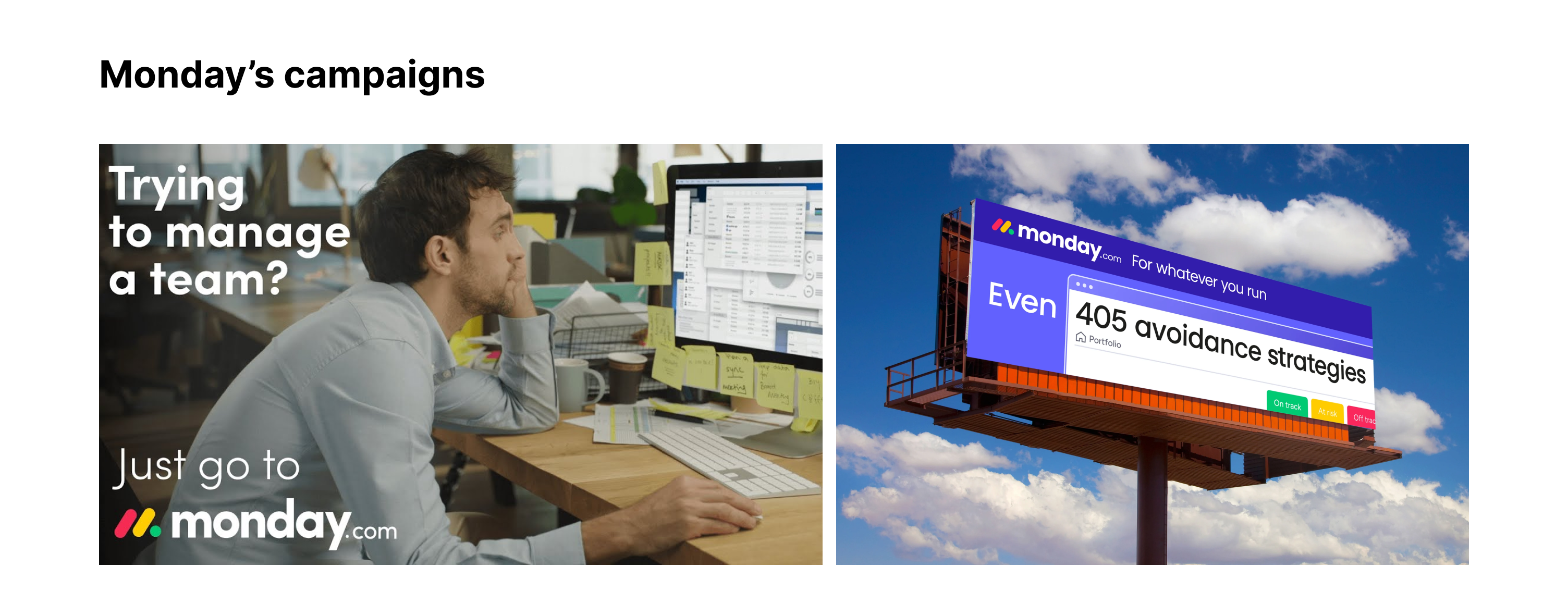
Also, the core message of Monday’s campaigns is as simple as it gets – it’s expressed in just a few words. This instantly creates a link between a specific need (managing a team or a project) and the business that helps satisfy it.
2. Add emotional impact
Emotions in B2B marketing matter a lot more than you might think. Decision-makers in the B2B sector are human too, which means they’re influenced not just by rational motivators (like price and functionality), but also the emotional and subjective ones (like reputation and social responsibility). Using subtle emotional triggers in your campaigns opens a whole new world full of opportunities.
Here’s the first tactic: instead of just talking about what your product does, tell a story and show how it makes life easier or better for the business.
For example, tell a story about a real customer: they face a specific problem, find your product, and then use it as a solution. It’s a simple storytelling formula that works for both B2C and B2B advertising: problem => solution => benefit. Visuals can be a big help here: videos and strong imagery can quickly grab attention and create an emotional connection.
You can also focus on the outcomes: talk about how your product reduces stress, boosts efficiency, or gives decision-makers peace of mind. Using positive emotions (hope, excitement, satisfaction) creates the association between your business and what makes your customers feel good.
Another tactic is to address common fears and concerns. Your buyers are likely worried about making the wrong choice, but you can position your product as the safe and smart solution. Giving reassurances and, most importantly, providing facts to back up your promises helps you build trust among your audience.
And don’t forget that you can always create a sense of urgency. For example, emphasize that by choosing your product now, your customers will avoid future problems or grab a great opportunity.
Now, let’s look at two examples of using emotions in B2B marketing and advertising campaigns.
IBM’s “Every Second Counts” campaign, launched on Valentine’s Day, puts an emotional twist on a banal problem: e-commerce companies losing power when they need it the most. The simple problem => solution => benefit formula takes on a new, more memorable and engaging form.
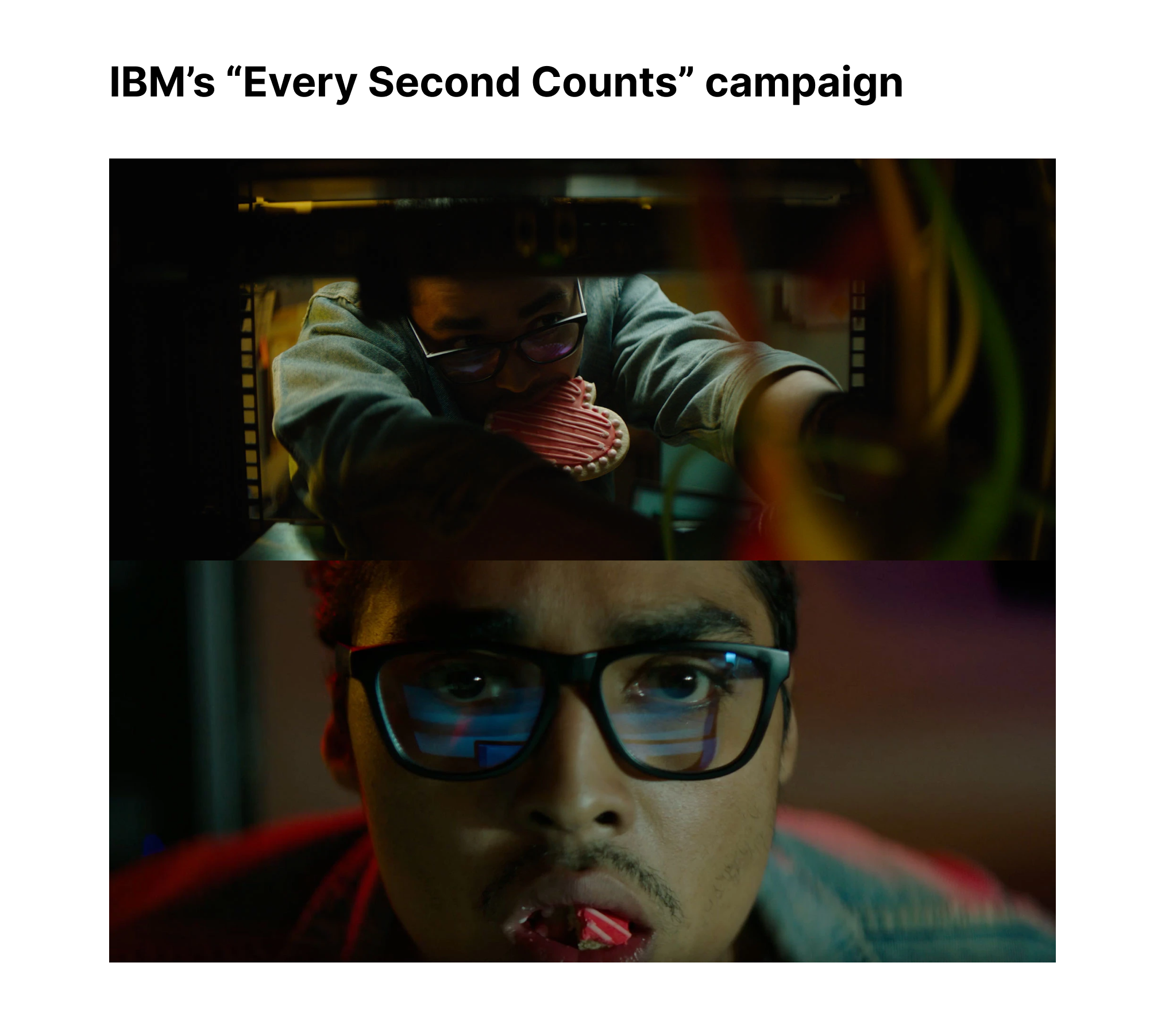
This campaign proves that appealing to our common humanity works wonders in B2B, too.
Then, we have Pinterest’s “The P is for Performance” campaign. It's aimed at advertisers who want to connect with Gen Z and does it in a really engaging way – by using mini-movies to show the brand’s newest products for advertisers.
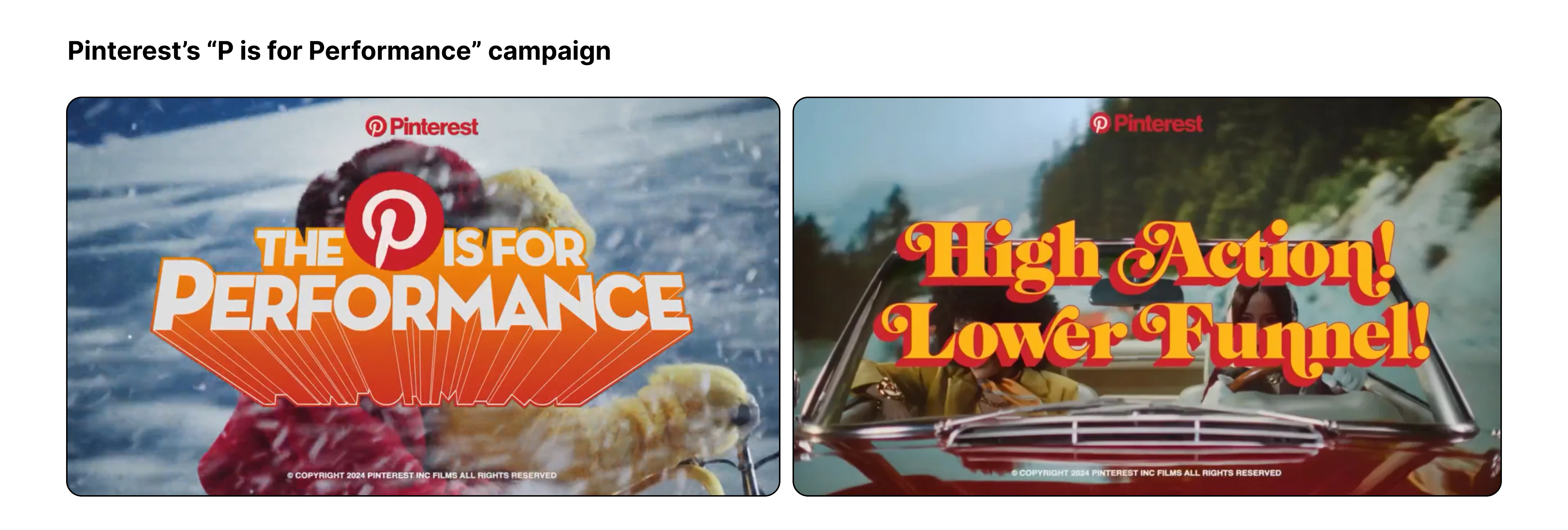
Pinterest tapped into pop culture and iconic action movies to create an exciting story that stands out from typical B2B marketing. That’s how you make a B2B brand memorable.
3. Appeal to logic, not just emotions
Connecting with your audience on an emotional level is important, but mixing emotion with logic is the real winning combo. Think of it this way: emotions get people interested, but facts make them believe in your product. That’s especially true for the B2B buying journey.
So, start by showing how your product or service can actually make a difference. For example, if you advertise a project management software, explain how much faster your customers’ workflows will be and what that means for their businesses through numbers and data. Instead of saying, “Our software helps you manage projects” say, “Our software saves your team 10 hours a week on project management tasks”.
If you combine it with an appeal to emotions (you can show how chaotic and unmanageable projects can be without your tool), your emotional pitch will have some solid proof behind it.
Another way to appeal to the rational and logical side of your customers is to build trust based on real accomplishments. Don’t be afraid to flaunt the industry awards, certifications, or accolades your company has received – you have to let everyone know there are solid reasons to choose you.
It’s also smart to highlight partnerships you have with well-known brands: this not only boosts your credibility but also makes potential clients feel more at ease about their choice.
Basically, the best approach to B2B advertising is to blend the emotional appeal with concrete data and proven credentials to create a more compelling and trustworthy message.
For example, Spotify’s “Wrapped for Advertisers” campaign took their popular end-of-the-year “Spotify Wrapped” idea and made a version for their B2B clients.
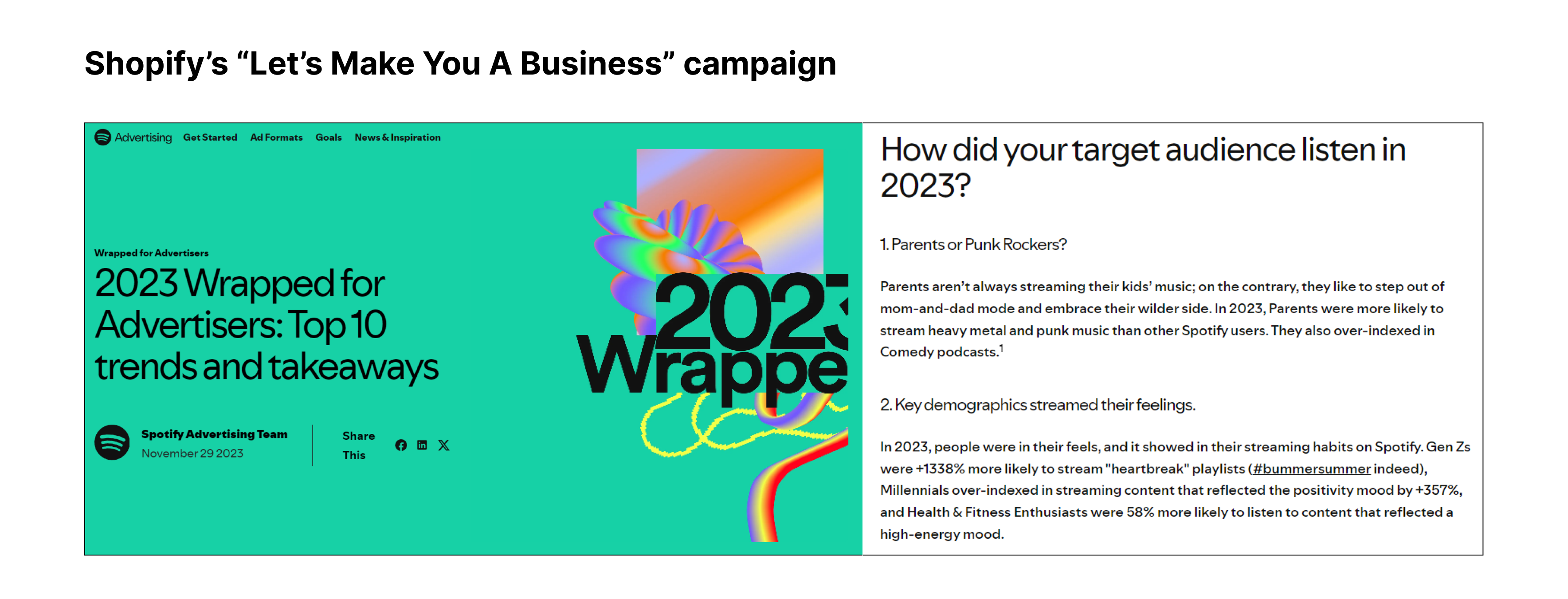
The campaign shared data showing how audiences and advertisers connect on Spotify, giving business clients insights to inform their campaigns. This shows how B2B marketers can use data to speak to clients who make more logical, data-driven decisions.
4. Personalize
Personalization is just as important in B2B advertising as it is in B2C.
Why? As we’ve said before, both B2B and B2C buyers are people, and people respond better to messages that feel personal and relevant to them. When decision makers see content or ads that address their particular needs, they’re more likely to notice and take your offers seriously.
Here’s how to do it: tailor your messages to speak directly to the decision-makers you’re targeting. Think about their specific needs and challenges and address them. For example, if you know a company is struggling with a particular task or process (which you could learn by reading LinkedIn posts of the employees or executives), highlight how your solution makes that easier. Show them that you understand their unique issues, are ready to solve them, and how you can do it.
It’s also better to not go for one-size-fits-all: customize your campaigns for different industries or roles within a company. Develop several buyer personas with specific needs and pain points and create messages that speak to each of them – that’s how you approach all of the key audience segments with your solutions.
That being said, you can personalize your campaigns while still maintaining a universal appeal. For example, Shopify’s “Let’s Make You A Business” omnichannel campaign shows how to make a B2B campaign feel personal while reaching different demographics and segments. The campaign targeted all aspiring entrepreneurs, motivating them to turn their ideas into reality with Shopify’s help.
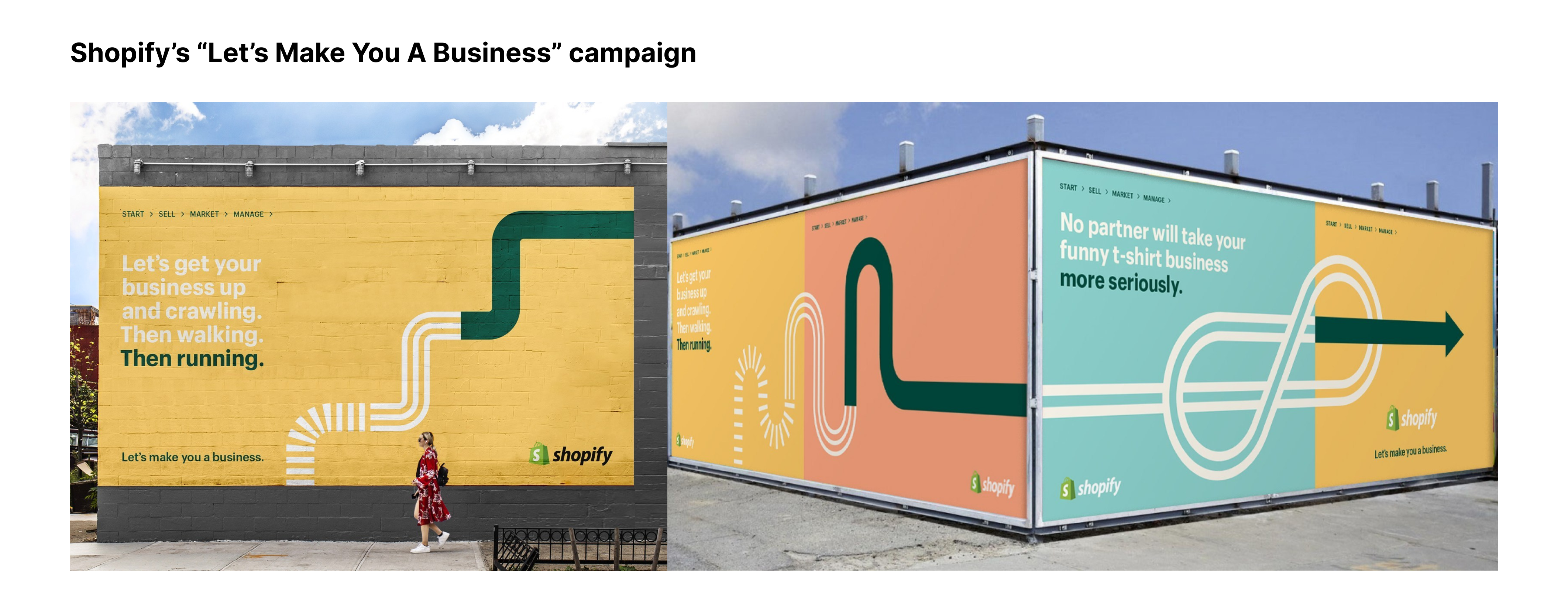
Shopify wanted to become the go-to brand for anyone starting a new business, and this highly visible campaign definitely helped make that happen.
Recap
To sum up, B2B marketing doesn’t have to be boring or overly complicated.
By understanding the fundamentals and putting your own spin on them, you can create campaigns that resonate with B2B clients. The key is to blend clear value propositions with emotional appeal and facts, and also make it personal.
With the right strategies, you’ll not only engage your audience but also drive meaningful results. So, take these insights and apply them to your campaigns – you’ll be surprised by the results.

